02.10.11
Posted in Non-US Weather, Tropical Weather, Weather News at 4:14 pm by Rebekah
Parts of Australia have been flooding for the past couple of months now. With even more rainfall following Tropical Cyclone Yasi’s landfall last week, how is the country doing lately in terms of rainfall amounts and river heights?
February 3 – February 10 rainfall totals (Bureau of Meteorology)
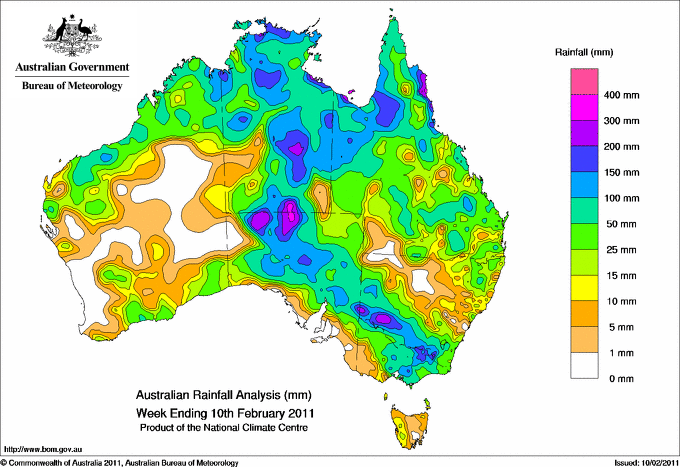
The biggest thing that pops out at me from this map is the swath of higher rainfall from northern Queensland southwestward to the south central part of the Northern Territory, as a result of Tropical Cyclone Yasi, as well as the swath of rain from north central South Australia southeastward through northern Victoria / southern New South Wales, as a result of a trough of low pressure.
Current river conditions (Bureau of Meteorology)
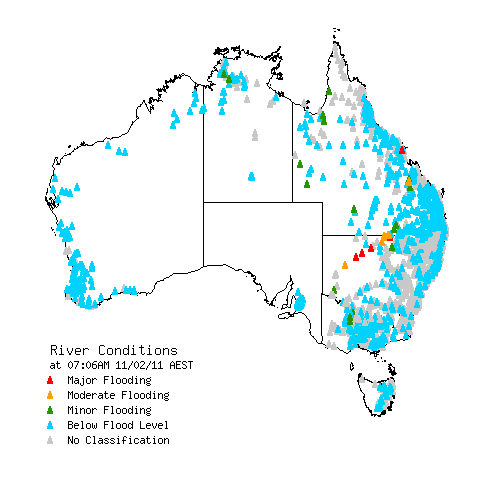
This map is better than those from a few weeks ago (see below); most of the rivers are below flood level now, with the exception of a few in Queensland and New South Wales.
November 26 – January 20 peak river conditions (Bureau of Meteorology)
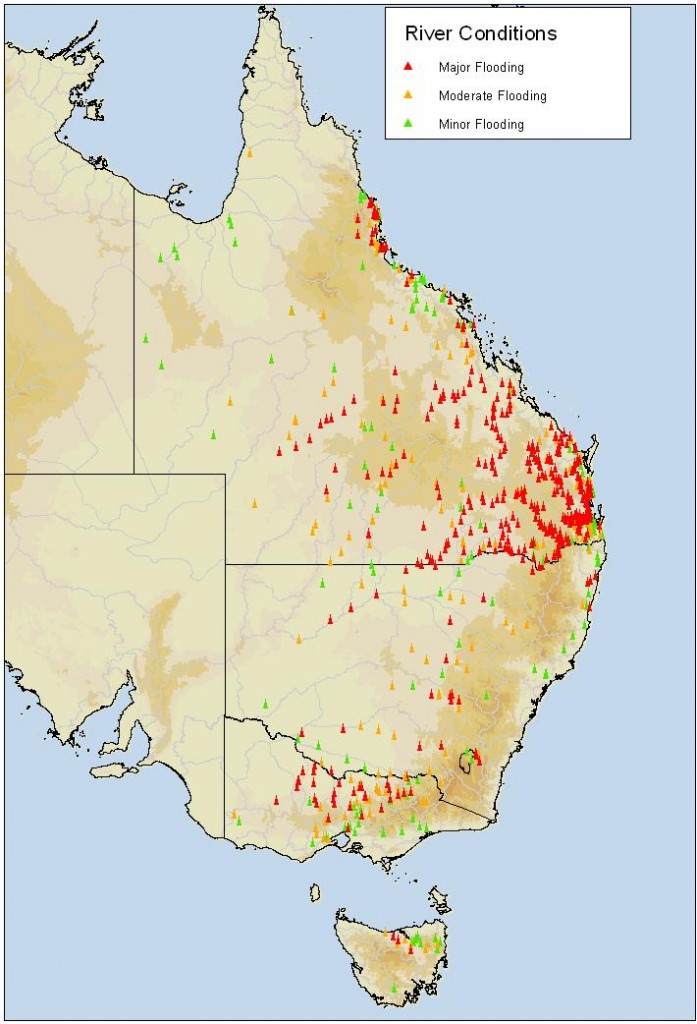
Now for a look at some rainfall maps from over the past three months…
November 1 – January 31 rainfall totals (Bureau of Meteorology)
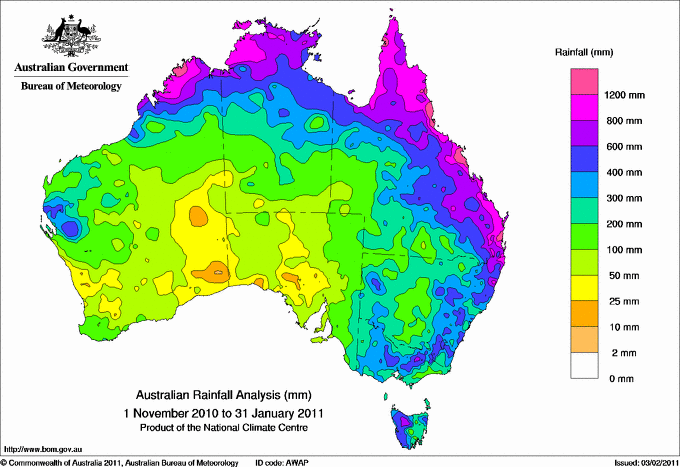
November 1 – January 31 rainfall anomalies (Bureau of Meteorology)
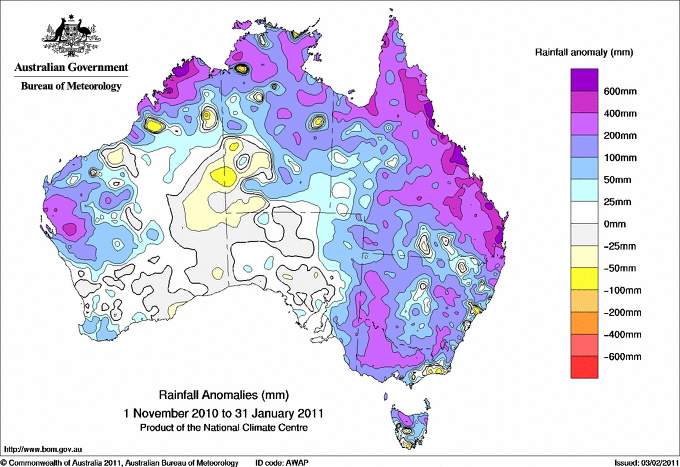
Wow, many coastal areas received well above average rainfall! Now how does this rainfall compare to the average rainfall?
November 1 – January 31 rainfall percentages (Bureau of Meteorology)
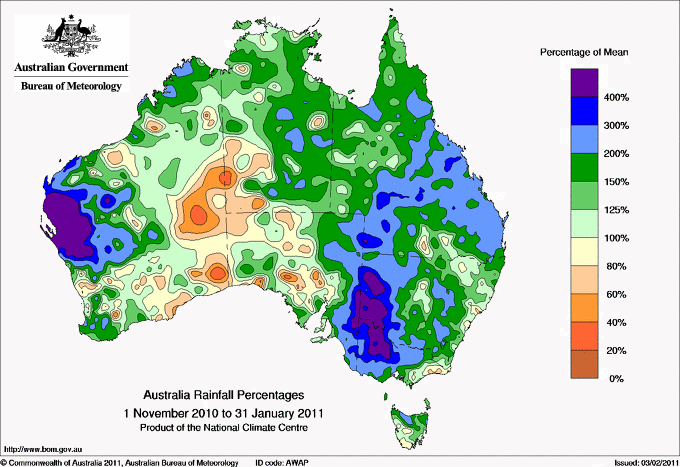
Okay, so most of eastern Australia experienced above average rainfall from November through January. More specifically, western New South Wales and Victoria had well above average rainfall, as well as the west central coast of Western Australia.
Now how does this compare to the records?
November 1 – January 31 rainfall deciles/records (Bureau of Meteorology)
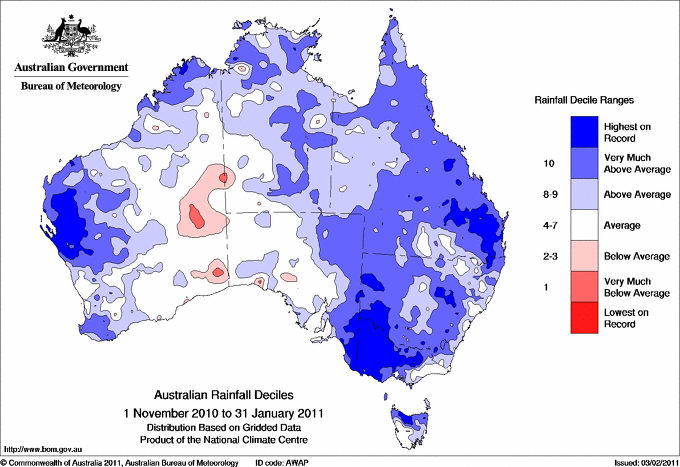
This map shows that the rainfall in most of eastern Australia was well above average…much of Victoria, western New South Wales, and southeastern Queensland broke all-time rainfall records. That’s a pretty large record-breaking area! Note also that the west central coast of Western Australia has also received the highest amount of rainfall on record.
Has the rain affected the temperatures much? Absolutely.
November 1 – January 31 mean temperature anomaly (Bureau of Meteorology)
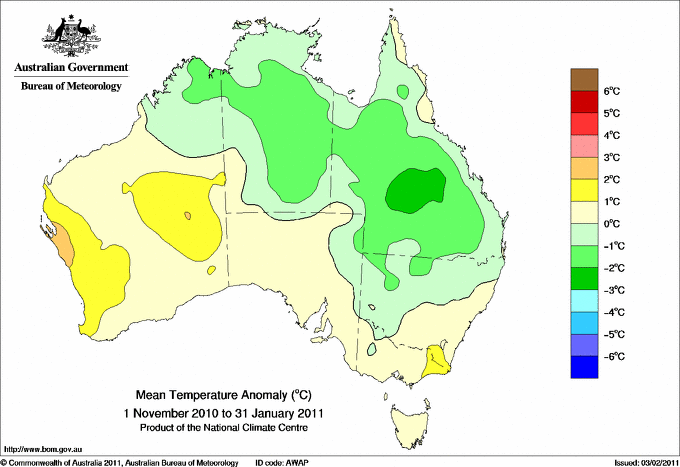
It’s not a coincidence that Queensland’s average temperatures were lower from November through January…the clouds and rain contributed quite a bit to the slightly cooler weather.
For more on Australia’s climate data, check out the following links from the Bureau of Meteorology: Queensland in January 2011: Widespread flooding continued; Special Climate Statement 24 [on frequent heavy rains in late 2010 / early 2011, PDF document]; and Severe Tropical Cyclone Yasi [maps and info]. To see more of the above maps, check out the links posted in the captions.
One more thing: models show another tropical cyclone could develop in the Gulf of Carpentaria next week (and make landfall) and another cyclone off the coast of Western Australia by next weekend (though it would move away).
Here’s a map from the BoM showing the average annual number of tropical cyclones around Australia (click to enlarge):
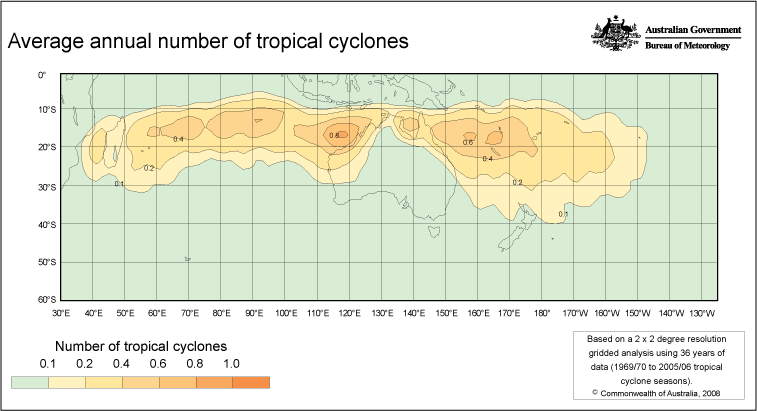
Compare that to a La Niña year, which we’re in now:
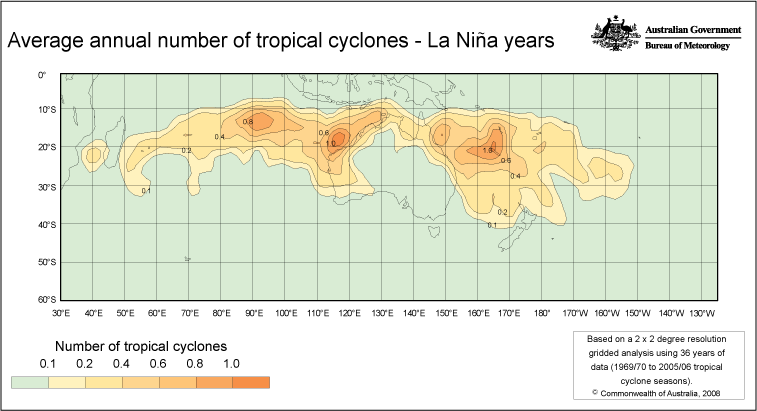
Stay tuned and stay safe!
Permalink
Posted in Weather News, Winter Weather at 12:16 pm by Rebekah
Daily record lows are broken all the time. But it isn’t every day that the all-time record low for an entire state is broken.
Early this morning the temperature dropped to –28 °F in Bartlesville, in northeast Oklahoma. That’s 28 BELOW ZERO. This broke the previous all-time record low for Oklahoma, -27 °F, set in 1905 and tied in 1930. Note: this value is “unofficial”, meaning it will have to go through review for it to become an official low.
The recent heavy snowfall in northern Oklahoma helped in this case, as temperatures will drop more when there is a heavier snowpack.
Based on the Oklahoma Mesonet, the temperature got even lower than this, though, as Nowata, Oklahoma (near Bartlesville) reached -31 °F this morning. However, as this was not a standard recording station set up by the NWS or FAA, the temperature will likely remain unofficial.
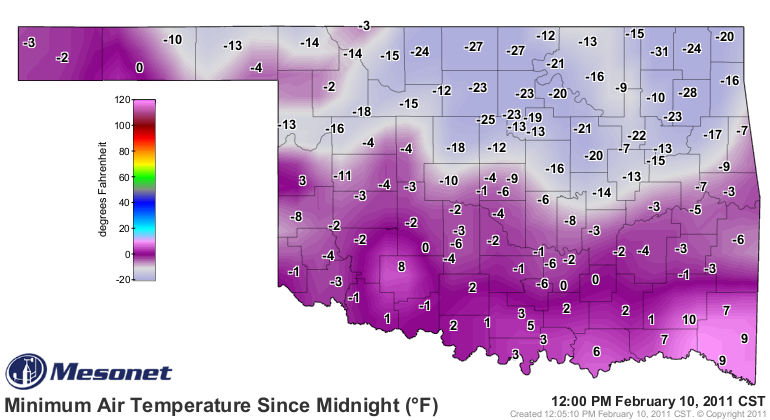
Oklahoma Mesonet, showing the lowest recorded temperatures since midnight.
Oklahoma City dropped to -5 °F, a new record low for February 10th for the city (plus Oklahoma City hadn’t dropped below zero since February 1996), and Tulsa dropped to -12 °F last night, tied for 5th lowest and the coldest since 1930.
Other record lows for the 10th include Springfield, Missouri (-10 °F), Wichita, Kansas (-17 °F), Amarillo, Texas (-6 °F), Dallas, Texas (15 °F), and Austin, Texas (19 °F).
Relief is on the way, though…temperatures could hit 70 °F here in central Oklahoma on Sunday! 🙂
Permalink
02.08.11
Posted in Non-US Weather, Weather News at 8:00 am by Rebekah
This week’s post in the global weather and climate series features Vancouver, British Columbia, Canada.
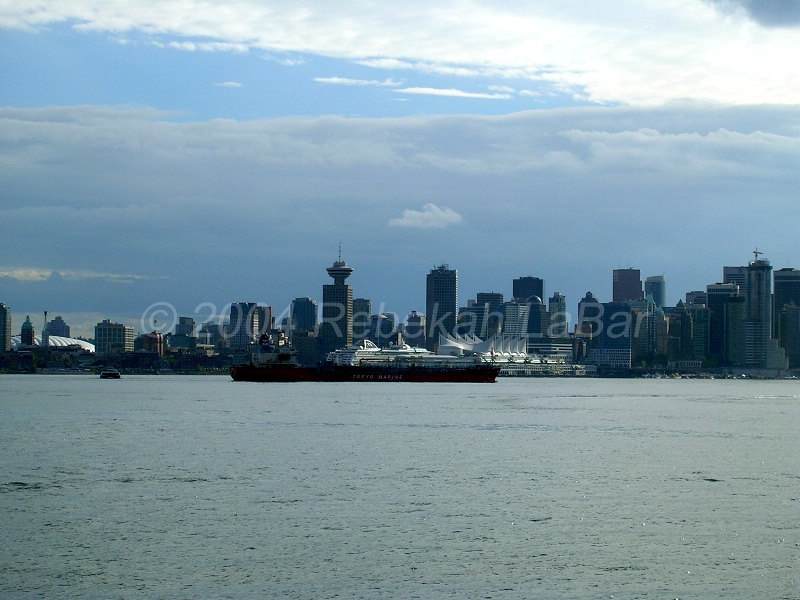
Vancouver, looking across the harbour from North Vancouver
Vancouver lies on the southwest coast of Canada, and with a metropolitan population (2006) of 2,116,581 (urban: 578,041), it is the most populous city in western Canada and the third largest in the country (in terms of the metro). Immigration has increased dramatically in recent years, and as many as 30% of the city’s population is of Chinese heritage (~52% of the city’s population does not speak English as their first language).
The primary industry of Vancouver is logging; in fact, the city began in the mid-1800s as a logging town. The port of Vancouver (Port Metro Vancouver) is also a vital part of the city, and is the fourth largest port (by tonnage) in North America, after South Louisiana, Houston, and New York/Newark. The second largest industry in Vancouver is tourism. Vancouver is also the third largest film-production center in North America, after Los Angeles and New York City. You may recognize the skyline of Vancouver in some TV shows and movies.
A few more facts about Vancouver (from Wikipedia):
- Time zone: Pacific Standard Time (UTC-8) or Pacific Daylight Time (UTC-7)
- Average elevation: 7 ft (2 m)
- Climate zone: Oceanic or marine west coast
- Average high temperature: 57 °F (14 °C)
- Average low temperature: 44 °F (7 °C)
- Average annual high/low temperature range: 43 to 71 °F (6 to 22 °C) / 33 to 56 °F (1 to 13 °C)
- Record high temperature: 94 °F (34 °C)
- Record low temperature: 0 °F (-18 °C)
- Average annual precipitation: 47 inches (1,199 mm)
- Average annual rainfall: 45 inches (1,155 mm)
- Average annual snowfall: 19 inches (48 cm)
Weather: In contrast to last year during the 2010 Winter Olympics, Vancouver has been seeing near average temperatures lately. January did bring above average rainfall, though, and that has been due in large part to an occasional stream of moisture from the central Pacific known as the Pineapple Express. The ridge in place over the eastern Pacific has been great for pulling the moisture northward into southwest Canada and the northwest U.S.
This mild, wet pattern is likely to continue for at least the next week or so.
As far as snow, here’s a snow depth map for British Columbia from The Weather Network:
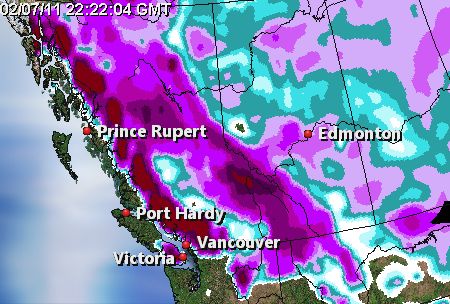

For weather maps and information on current and forecast Vancouver weather, see Environment Canada, Weather Underground, and The Weather Network.
For more information on Vancouver, here’s a link to Wikipedia.
Next Tuesday I plan to take a look at the climate and weather in another part of the globe. As always, if you have any suggestions for future cities, please leave a comment!
Permalink
02.05.11
Posted in Non-US Weather, Weather News at 8:00 am by Rebekah
Have you ever heard of the Pineapple Express?
The Pineapple Express is a term for a plume of moisture that originates around the east central Pacific (often near Hawaii) and travels up to the West Coast of the United States. This band of moisture is often responsible for heavy rain, snow, and/or flooding events from the Pacific Northwest to southern California.
Now, have you ever heard of the Rum Runner?
The Rum Runner is a similar moisture plume that runs from the eastern Caribbean up to western Europe. This atmospheric river of moisture is also responsible for many of the heavier rain and flooding events from Ireland and the United Kingdom to Spain.
Examples
The following map (click to enlarge), from Jason Cordeira’s website, shows global 250 mb heights (the “dips” in the northern hemisphere are troughs of low pressure, while the “mountains” are ridges of high pressure…the reverse is true for the southern hemisphere) and precipitable water (the amount of water that would be measured if all the moisture in the atmosphere at that point fell out as rain). The important part to note here is that the colors are showing moisture, and the bigger the number, the greater the moisture.
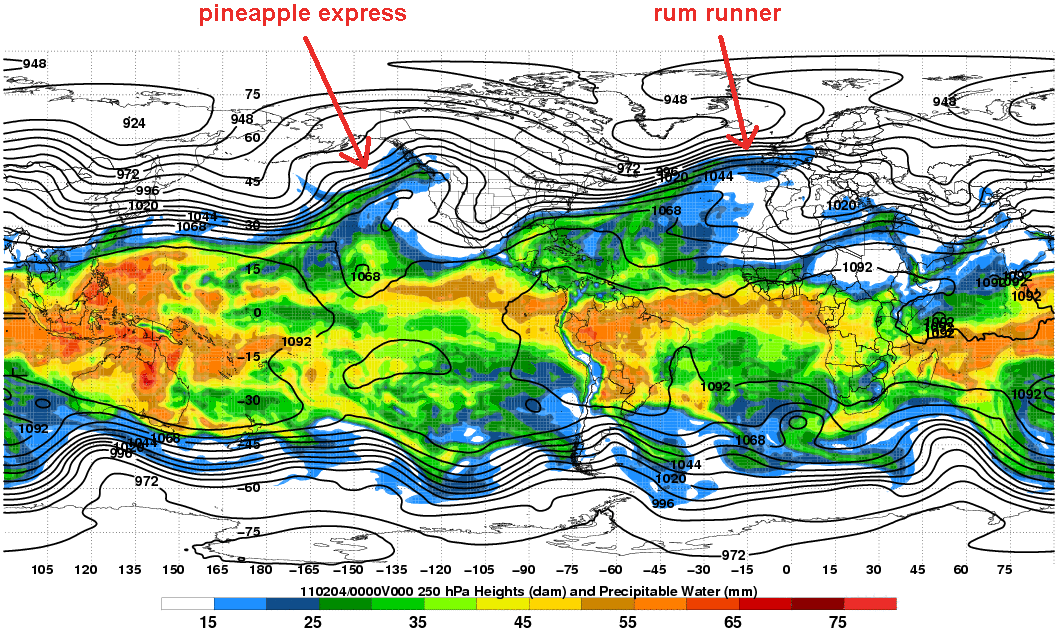
Note the plume of moisture being transported from the central Pacific up into British Columbia and Washington State…this is the Pineapple Express.
Note also the plume of moisture being transported from the western Atlantic up into Ireland and United Kingdom…this is the Rum Runner.
The infrared satellite image below, from the U.K. Met Office website, also shows evidence of the Rum Runner in the thin band of clouds that stretch across the image into southern Scandinavia.
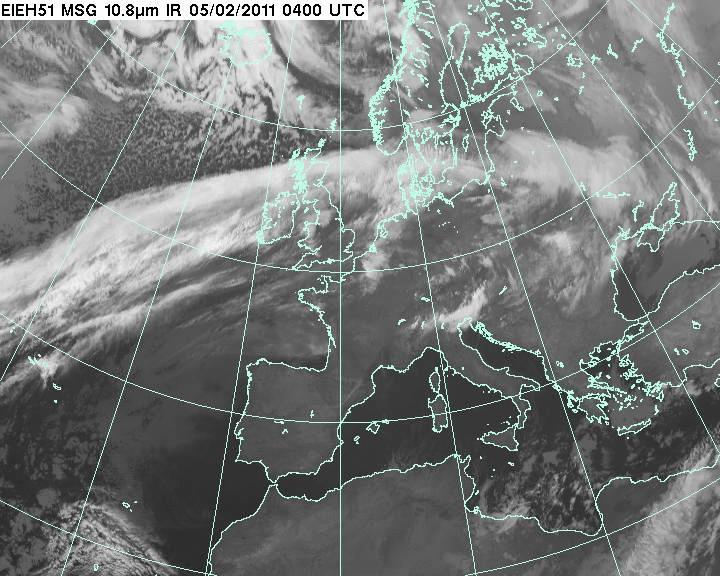
The Rum Runner is stronger when there is a strong westerly jet stream, as there is now. The stronger jet stream is a result of a stronger Icelandic Low and Azores High (for more on the North Atlantic Oscillation, see this blog post and this Wikipedia).
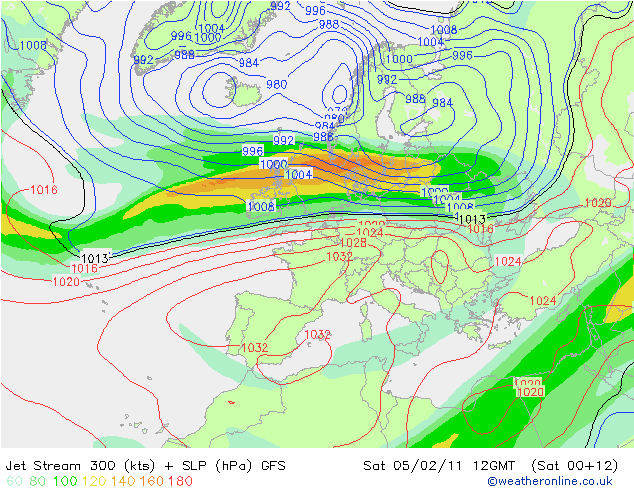
The above map shows surface pressure (contoured) and the 300-mb jet stream (filled colors), from Weather Online UK, for 12Z this morning. Note the low pressure over northern Europe and the high pressure over Spain, contributing to the higher wind speeds in the jet stream. This jet stream is transporting the deep plume of moisture into northern Europe (see also below, including precipitation).
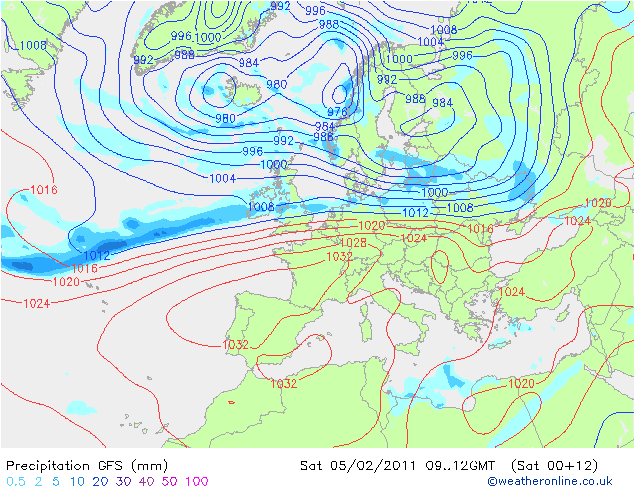
I recommend checking out the animation of the above precipitable water map, to get a better appreciation for how these atmospheric rivers move. It’s pretty cool, and can be found at the website of Jason Cordeira, student at SUNY Albany.
Permalink
02.04.11
Posted in Weather News, Weather Summary at 6:00 pm by Rebekah
The past week has been a brutal one for parts of the U.S. and Canada, what with frigid temperatures, ice, snow, and blizzard conditions (not to mention severe thunderstorms and tornadoes in the Southeast).
Now here’s a summary of what the weather in the U.S. is doing today and what it may do in the near future.
Snow cover as of 12Z (7 am Eastern, 4 am Pacific), from WSI:
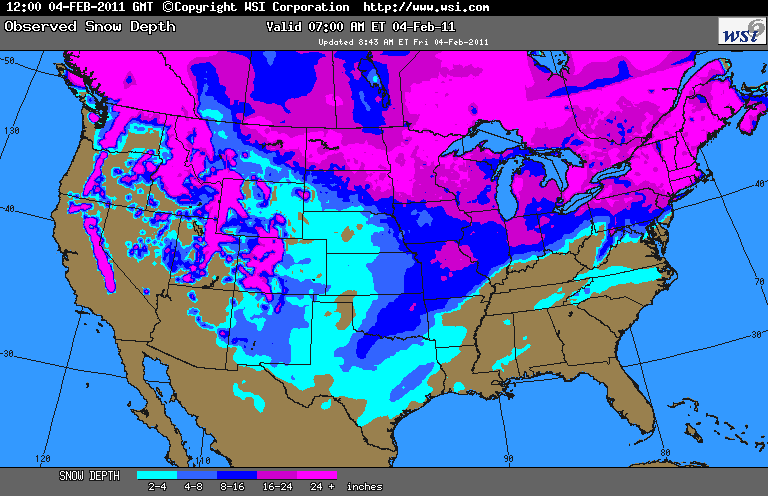
A few observations: most of Texas is covered in snow, as well as Oklahoma. Hmm…ironic how the Super Bowl is in Dallas this weekend and the city gets several inches of ice and snow. Note also that the path of the recent ice/snow storm is fairly evident, from the Southern Plains up into the Northeast.
Surface map as of 6:30 pm Eastern, 3:30 Pacific, from The Weather Channel:
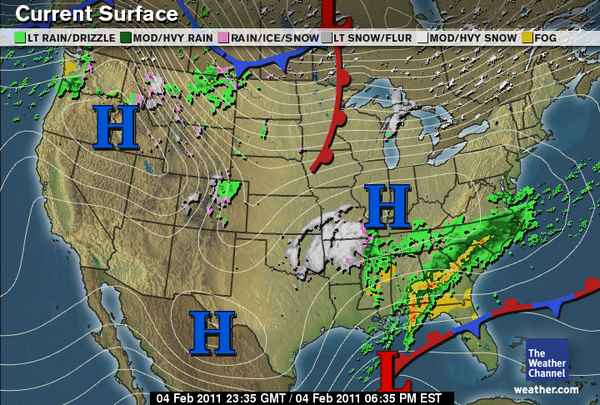
Highlights:
- High pressure over the Northwest
- Rain is falling in western Washington
- Snow is falling in the Rockies of northern Idaho and western Montana
- Rain is falling in eastern Montana, ahead of a cold front stretching from a surface low in eastern Ontario down through southern Saskatchewan and up into northern Alberta
- There is also a warm front extending south of the low in Ontario down through Minnesota
- There is a small band of snow and ice falling from Lake Superior to northern Lake Michigan
- Some rain and snow is falling in northern Colorado
- The southern Midwest into the Southern Plains is dominated by high pressure
- Snow is falling from central Oklahoma into Arkansas and southern Missouri
- Rain is falling from Kentucky and Virginia southward to Mississippi and the Florida Panhandle
- There is a surface low in the Gulf of Mexico, with a stationary front extending eastward into the Atlantic
500 mb map as of 12Z, from the Storm Prediction Center:
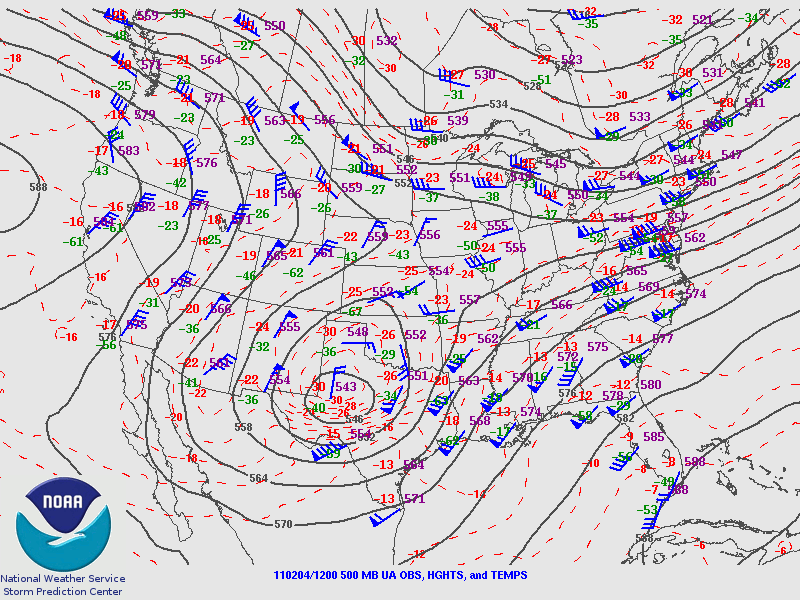
Note the pattern of a ridge in the west and a trough in the central to eastern U.S. continues…this morning the shortwave trough was over Texas, and the lift on the eastern side of this shortwave is what’s partially responsible for the snow falling from Oklahoma to Missouri.
Temperatures as of 6:45 pm Eastern, 3:45 Pacific, from The Weather Channel:
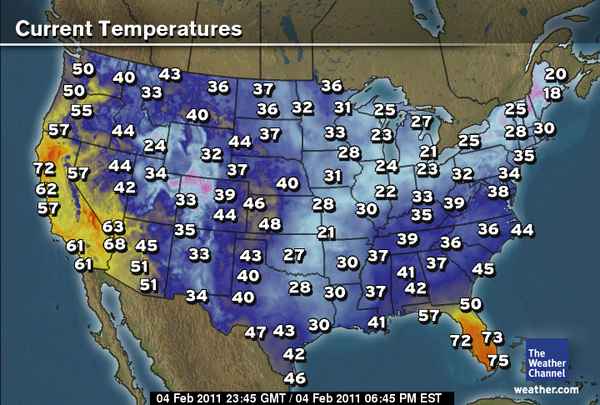
All I can say is I wish I was in California or southern Florida about now!
A few notes on upcoming weather:
- Northeast: a new low is expected to form Saturday, and will strengthen over New England overnight…snow and freezing rain is expected in southern New England on Saturday and snow a bit further north through Monday
- Midwest: another low will form tomorrow over the western Midwest, bringing some snow and sleet to the eastern Dakotas into Minnesota and Iowa
- Northwest: another wet week for western Washington, with another plume of moisture coming up from the central Pacific…snow, sleet, and freezing rain expected for eastern Montana tonight and tomorrow, as well as into the Dakotas
- Southwest: dry and warmer in the southwest over at least the next few days…L.A. could get to 80 on Sunday
- South central: The next few days could be snowy off and on for parts of the Southern Plains, though Dallas should be dry (but in the lower 40s) for the Super Bowl on Sunday
- Southeast: Warm in Florida (in the 70s!) but rainy over parts of the Southeast for at least the next couple of days
6-10 day temperature and precipitation outlooks, from the Climate Prediction Center:
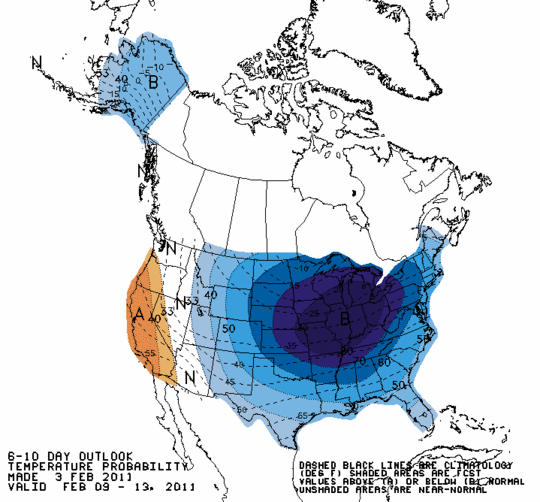
Well below normal temperatures for much of the U.S.! Brrr!!
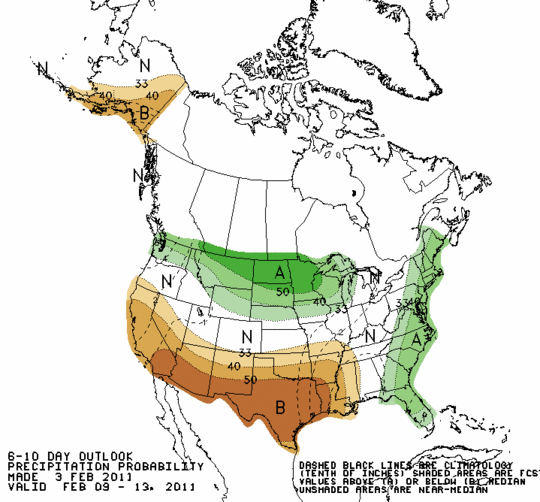
Permalink
« Previous Page — « Previous entries « Previous Page · Next Page » Next entries » — Next Page »






















